Multivariate Analysis of Magnetic Parameters and Trace Metals in Atmospheric Dustfall and Its Environmental Implications in Northern China
Abstract
:1. Introduction
2. Materials and Methods
2.1. Study Area and Sampling
2.2. Descriptive Analysis, Correlation Analysis, and Multivariate Analysis
3. Results and Discussion
3.1. Elemental Concentrations
3.2. Correlation Analysis
3.3. Principal Component Analysis
3.4. Source Identification of Trace Metals
3.4.1. Inner Mongolia
3.4.2. Hebei Province
3.5. Magnetic Properties
3.6. Correlations among Magnetic Properties and Trace Metal Concentrations
3.7. Environmental Implications
4. Conclusions
Author Contributions
Funding
Data Availability Statement
Conflicts of Interest
References
- Petrovský, E.; Ellwood, B.B. Magnetic monitoring of air- land- and water-pollution. In Quaternary Climates, Environments and Magnetism; Maher, B.A., Thompson, R., Eds.; Cambridge University Press: Cambridge, UK, 1999; pp. 279–322. [Google Scholar]
- Petrovský, E.; Zbořil, R.; Matys Grygar, T.; Kotlík, B.; Novák, J.; Kapička, A.; Grison, H. Magnetic particles in atmospheric particulate matter collected at sites with different level of air pollution. Stud. Geophys. Geod. 2013, 57, 755–770. [Google Scholar] [CrossRef]
- Shu, J.; Dearing, J.A.; Morse, A.P.; Yu, L.Z.; Yuan, N. Determining the sources of atmospheric particles in Shanghai, China, from magnetic and geochemical properties. Atmos. Environ. 2001, 35, 2615–2625. [Google Scholar] [CrossRef]
- McConnell, J.R.; Edwards, R. Coal burning leaves toxic heavy metal legacy in the Arctic. Proc. Natl. Acad. Sci. USA 2008, 105, 12140–12144. [Google Scholar] [CrossRef] [PubMed] [Green Version]
- Zhu, Z.M.; Sun, G.Y.; Bi, X.Y.; Li, Z.G.; Yu, G.H. Identification of trace metal pollution in urban dust from kindergartens using magnetic, geochemical and lead isotopic analyses. Atmos. Environ. 2013, 77, 9–15. [Google Scholar] [CrossRef]
- Chester, R.; Sharples, E.J.; Sanders, G.; Oldfield, F.; Saydam, A.C. The distribution of natural and non-crustal ferrimagnetic minerals in soil-sized particulates from the Mediterranean atmosphere. Water Air Soil Poll. 1984, 23, 25–35. [Google Scholar] [CrossRef]
- Hunt, A. The application of mineral magnetic methods to atmospheric aerosol discrimination. Phys. Earth Planet. Int. 1986, 42, 10–21. [Google Scholar] [CrossRef]
- Hunt, A.; Jones, J.; Oldfield, F. Magnetic measurements and heavy metals in atmospheric particulates of anthropogenic origin. Sci. Total Environ. 1984, 33, 129–139. [Google Scholar] [CrossRef]
- Oldfield, F.; Hunt, A.; Jones, M.D.H.; Chester, R.; Dearing, J.A.; Olsson, L.; Prospero, J.M. Magnetic differentiation of atmospheric dust. Nature 1985, 317, 516–518. [Google Scholar] [CrossRef]
- Castanheiro, A.; Samson, R.; De Wael, K. Magnetic- and particle-based techniques to investigate metal deposition on urban green. Sci. Total Environ. 2016, 571, 594–602. [Google Scholar] [CrossRef]
- Jordanova, N.V.; Jordanova, D.V.; Veneva, L.; Yorova, K.; Petrovsky, E. Magnetic response of soils and vegetation to heavy metal pollution—A case study. Environ Sci. Technol. 2003, 37, 4417–4424. [Google Scholar] [CrossRef]
- Wang, J.H.; Li, S.W.; Li, H.M.; Qian, X.; Li, X.L.; Liu, X.M.; Lu, H.; Wang, C.; Sun, Y.X. Trace metals and magnetic particles in PM2.5: Magnetic identification and its implications. Sci. Rep. 2017, 7, 9865. [Google Scholar] [CrossRef] [Green Version]
- Li, H.M.; Qian, X.; Wei, H.T.; Zhang, R.B.; Yang, Y.; Liu, Z.; Hu, W.; Gao, H.L.; Wang, Y.L. Magnetic properties as proxies for the evaluation of heavy metal contamination in urban street dusts of Nanjing, Southeast China. Geophys. J. Int. 2014, 199, 1354–1366. [Google Scholar] [CrossRef] [Green Version]
- Xia, D.S.; Wang, B.; Yu, Y.; Jia, J.; Nie, Y.; Wang, X.; Xu, S.J. Combination of magnetic parameters and heavy metals to discriminate soil-contamination sources in Yinchuan—A typical oasis city of Northwestern China. Sci. Total Environ. 2014, 485–486, 83–92. [Google Scholar] [CrossRef]
- Blaha, U.; Basavaiah, N.; Deenadayalan, K.; Borole, D.V.; Mohite, R.D. Onset of industrial pollution recorded in Mumbai mudflat sediments, using integrated magnetic, chemical, 210Pb dating, and microscopic methods. Environ. Sci. Technol. 2011, 45, 686–692. [Google Scholar] [CrossRef]
- Ma, M.M.; Hu, S.Y.; Cao, L.W.; Appel, E.; Wang, L.S. Atmospheric pollution history at Linfen (China) uncovered by magnetic and chemical parameters of sediments from a water reservoir. Environ. Pollut. 2015, 204, 161–172. [Google Scholar] [CrossRef]
- Cao, L.W.; Appel, E.; Hu, S.Y.; Yin, G.; Lin, H.; Rösler, W. Magnetic response to air pollution recorded by soil and dust-loaded leaves in a changing industrial environment. Atmos. Environ. 2015, 119, 304–313. [Google Scholar] [CrossRef]
- Wuyts, K.; Hofman, J.; Van Wittenberghe, S.; Nuyts, G.; De Wael, K.; Samson, R. A new opportunity for biomagnetic monitoring of particulate pollution in an urban environment using tree branches. Atmos. Environ. 2018, 190, 177–187. [Google Scholar] [CrossRef]
- Emerson, E.W.; Hodshire, A.L.; DeBolt, H.M.; Bilsback, K.R.; Pierce, J.R.; McMeeking, G.R.; Farmer, D.K. Revisiting particle dry deposition and its role in radiative effect estimates. Proc. Natl. Acad. Sci. USA 2020, 117, 26076–26082. [Google Scholar] [CrossRef]
- Yang, X.; Zhu, B.; Wang, X.; Li, C.; Zhou, Z.; Chen, J.; Wang, X.; Yin, J.; Lu, Y. Late Quaternary environmental changes and organic carbon density in the Hunshandake Sandy Land, eastern Inner Mongolia, China. Glob. Planet. Chang. 2008, 61, 70–78. [Google Scholar] [CrossRef]
- Cao, L.; Tian, W.Z.; Ni, B.F.; Zhang, Y.M.; Wang, P.S. Preliminary study of airborne particulate matter in a Beijing sampling station by instrumental neutron activation analysis. Atmos. Environ. 2002, 36, 1951–1956. [Google Scholar] [CrossRef]
- Yang, X.; Ding, Z.; Fan, X.; Zhou, Z.; Ma, N. Processes and mechanisms of desertification in northern China during the last 30 years, with a special reference to the Hunshandake Sandy Land, eastern Inner Mongolia. Catena 2007, 71, 2–12. [Google Scholar] [CrossRef]
- Qiao, Q.Q.; Huang, B.C.; Zhang, C.X.; Piper, J.D.A.; Pan, Y.P.; Sun, Y. Assessment of heavy metal contamination of dustfall in northern China from integrated chemical and magnetic investigation. Atmos. Environ. 2013, 74, 182–193. [Google Scholar] [CrossRef]
- Loska, K.; Wiechuła, D. Application of principal component analysis for the estimation of source of heavy metal contamination in surface sediments from the Rybnik Reservoir. Chemosphere 2003, 51, 723–733. [Google Scholar] [CrossRef] [PubMed]
- Megido, L.; Negral, L.; Castrillón, L.; Suárez-Peña, B.; Fernández-Nava, Y.; Marañón, E. Enrichment factors to assess the anthropogenic influence on PM10 in Gijón (Spain). Environ. Sci. Pollut. Res. 2017, 24, 711–724. [Google Scholar] [CrossRef] [PubMed]
- Zhang, R.; Cao, J.J.; Tang, Y.R.; Arimoto, R.; Shen, Z.X.; Wu, F.; Han, Y.M.; Wang, G.H.; Zhang, J.Q.; Li, G.H. Elemental profiles and signatures of fugitive dusts from Chinese deserts. Sci. Total Environ. 2014, 472, 1121–1129. [Google Scholar] [CrossRef]
- Bern, C.R.; Walton-Day, K.; Naftz, D.L. Improved enrichment factor calculations through principal component analysis: Examples from soils near breccia pipe uranium mines, Arizona, USA. Environ. Pollut. 2019, 248, 90–100. [Google Scholar] [CrossRef]
- Rubio, B.; Nombela, M.A.; Vilas, F. Geochemistry of Major and Trace Elements in Sediments of the Ria de Vigo (NW Spain): An Assessment of Metal Pollution. Mar. Pollut. Bull. 2000, 40, 968–980. [Google Scholar] [CrossRef]
- Blaser, P.; Zimmermann, S.; Luster, J.; Shotyk, W. Critical examination of trace element enrichments and depletions in soils: As, Cr, Cu, Ni, Pb, and Zn in Swiss forest soils. Sci. Total Environ. 2000, 249, 257–280. [Google Scholar] [CrossRef]
- China National Environmental Monitoring Centre (CNEMC). The Background Value of Chinese Soil; Environmental Science Press of China: Beijing, China, 2008; p. 501. (In Chinese) [Google Scholar]
- Shirani, M.; Afzali, K.N.; Jahan, S.; Strezov, V.; Soleimani-Sardo, M. Pollution and contamination assessment of heavy metals in the sediments of Jazmurian playa in southeast Iran. Sci. Rep. 2020, 10, 4775. [Google Scholar] [CrossRef] [Green Version]
- Zhang, J.; Liu, C.L. Riverine composition and estuarine geochemistry of particulate metals in China—weathering features, anthropogenic impact and chemical fluxes. Estuar. Coast. Shelf Sci. 2002, 54, 1051–1070. [Google Scholar] [CrossRef]
- Han, Y.M.; Du, P.X.; Cao, J.J.; Posmentier, E.S. Multivariate analysis of heavy metal contamination in urban dusts of Xi’an, Central China. Sci. Total Environ. 2006, 355, 176–186. [Google Scholar]
- Chen, J.M.; Tan, M.G.; Li, Y.L.; Zhang, Y.M.; Lu, W.W.; Tong, Y.P.; Zhang, G.L.; Li, Y. A lead isotope record of shanghai atmospheric lead emissions in total suspended particles during the period of phasing out of leaded gasoline. Atmos. Environ. 2005, 39, 1245–1253. [Google Scholar] [CrossRef]
- Deng, S.; Shi, Y.J.; Liu, Y.; Zhang, C.; Wang, X.F.; Cao, Q.; Li, S.G.; Zhang, F. Emission characteristics of Cd, Pb and Mn from coal combustion: Field study at coal-fired power plants in China. Fuel Process. Technol. 2014, 126, 469–475. [Google Scholar] [CrossRef]
- Adachi, K.; Tainosho, Y. Characterization of heavy metal particles embedded in tire dust. Environ. Int. 2004, 30, 1009–1017. [Google Scholar] [CrossRef]
- Adamiec, E.; Jarosz-Krzemińska, E.; Wieszała, R. Heavy metals from non-exhaust vehicle emissions in urban and motorway road dusts. Environ. Monit. Assess. 2016, 188, 369. [Google Scholar] [CrossRef] [Green Version]
- Wang, Y.F.; Huang, K.L.; Li, C.T.; Mi, H.H.; Luo, J.H.; Tsai, P.J. Emissions of fuel metals content from a diesel vehicle engine. Atmos. Environ. 2003, 37, 4637–4643. [Google Scholar] [CrossRef]
- Gad, S.C. Barium. In Encyclopedia of Toxicology, 3rd ed.; Wexler, P., Ed.; Academic Press: Oxford, UK, 2014; pp. 368–370. [Google Scholar]
- Wang, X.L.; Sato, T.; Xing, B.S.; Tamamura, S.; Tao, S. Source identification, size distribution and indicator screening of airborne trace metals in Kanazawa, Japan. J. Aerosol. Sci. 2005, 36, 197–210. [Google Scholar] [CrossRef]
- Pacyna, J.M. Source inventories for atmospheric trace metals. In Atmospheric Particles, IUPAC Series on Analytical and Physical Chemistry of Environmental Systems; Harrison, R.M., van Grieken, R.E., Eds.; Wiley: Chichester, UK, 1998; Volume 5, pp. 385–423. [Google Scholar]
- de Miguel, E.; Llamas, J.F.; Chacón, E.; Berg, T.; Larssen, S.; Røyset, O.; Vadset, M. Origin and patterns of distribution of trace elements in street dust: Unleaded petrol and urban lead. Atmos. Environ. 1997, 31, 2733–2740. [Google Scholar] [CrossRef]
- Manno, E.; Varrica, D.; Dongarrà, G. Metal distribution in road dust samples collected in an urban area close to a petrochemical plant at Gela, Sicily. Atmos. Environ. 2006, 40, 5929–5941. [Google Scholar] [CrossRef]
- Siegel, F.R. Environmental Geochemistry of Potential Toxic Metals; Springer: Berlin/Hidellberg, Germany, 2002. [Google Scholar]
- Thompson, R.; Oldfield, F. Environmental Magnetism; Allen & Unwin: Winchester, MA, USA, 1986. [Google Scholar]
- Liu, Q.S.; Roberts, A.P.; Larrasoaña, J.C.; Banerjee, S.K.; Guyodo, Y.; Tauxe, L.; Oldfield, F. Environmental magnetism: Principles and applications. Rev. Geophys. 2012, 50, 1–50. [Google Scholar] [CrossRef] [Green Version]
- King, J.; Banerjee, S.K.; Marvin, J.; Özdemir, Ö. A comparison of different magnetic methods for determining the relative grain size of magnetite in natural materials: Some results from lake sediments. Earth Planet. Sci. Lett. 1982, 59, 404–419. [Google Scholar] [CrossRef]
- Maher, B.A. Magnetic properties of some synthetic sub-micron magnetites. Geophys. J. Int. 1988, 94, 83–96. [Google Scholar] [CrossRef]
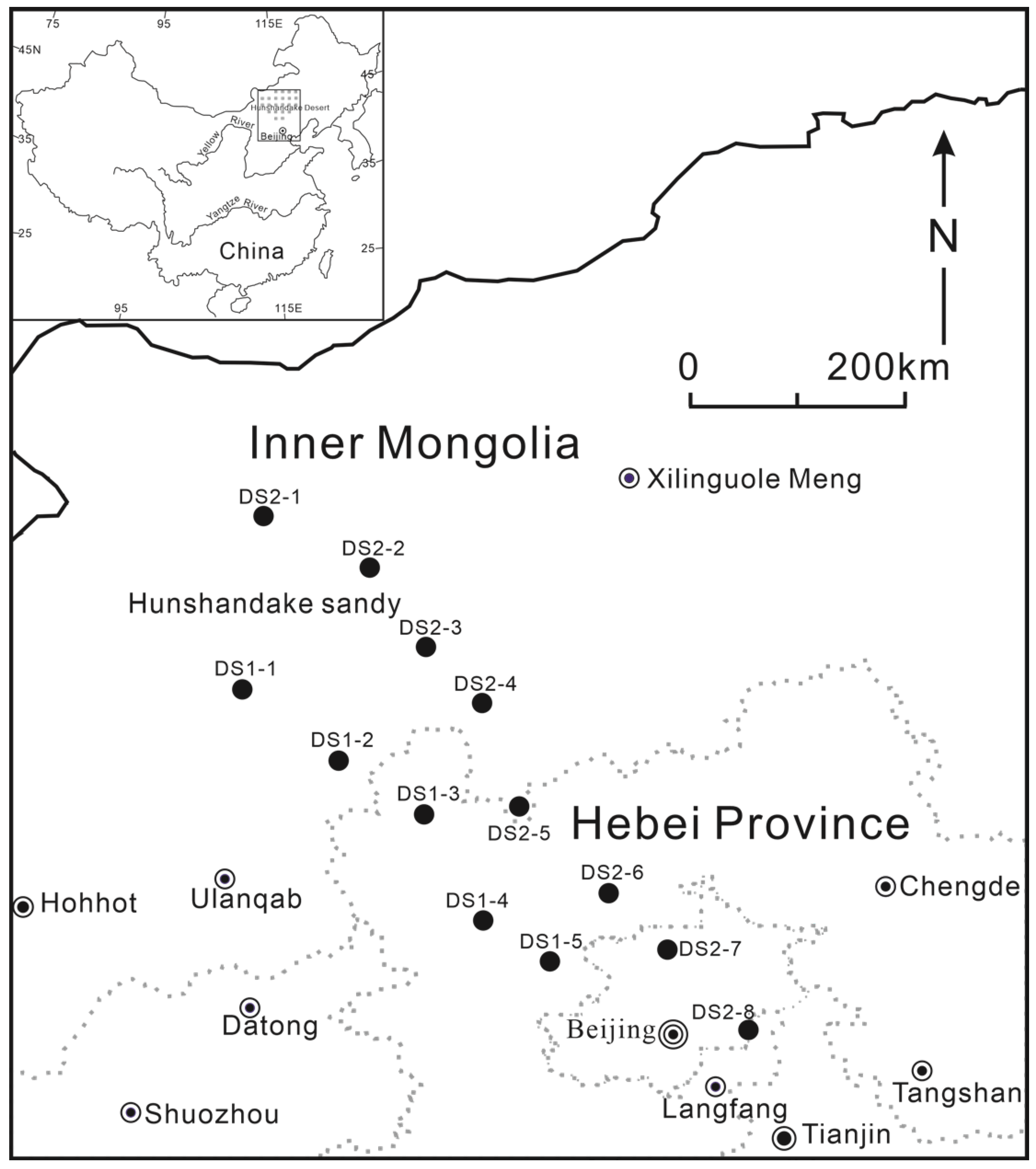
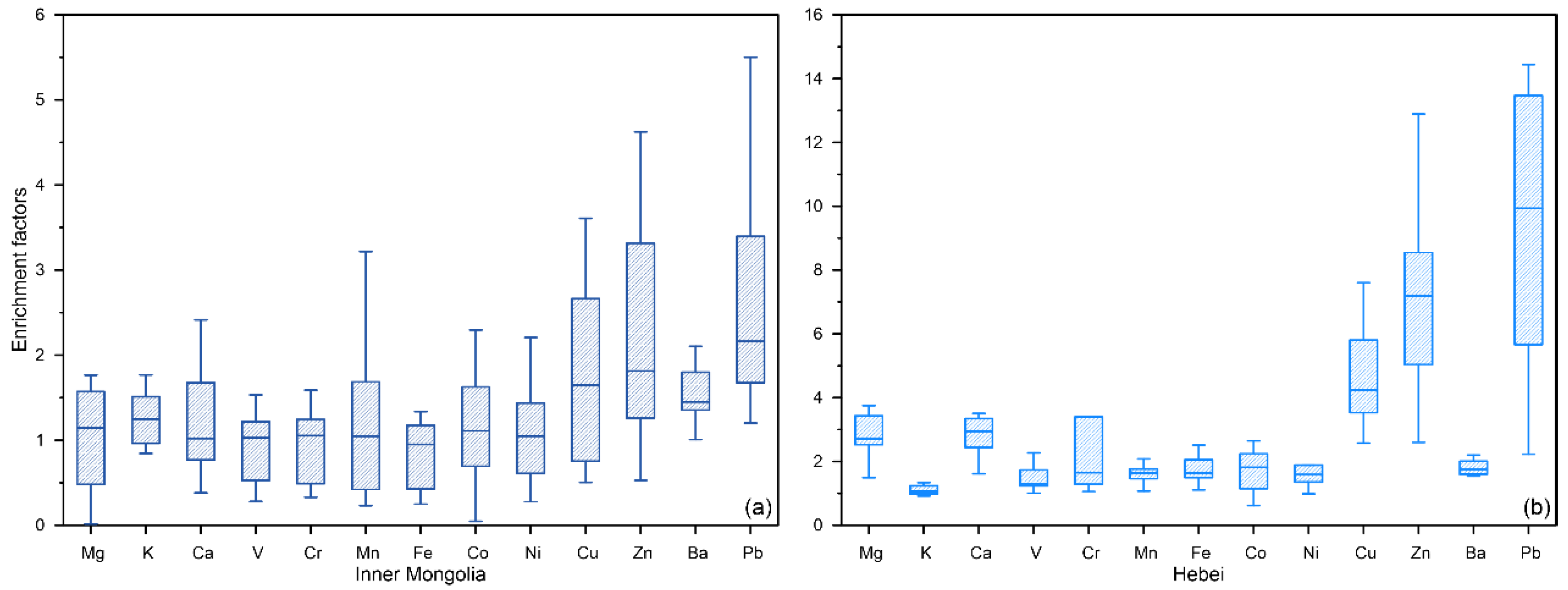
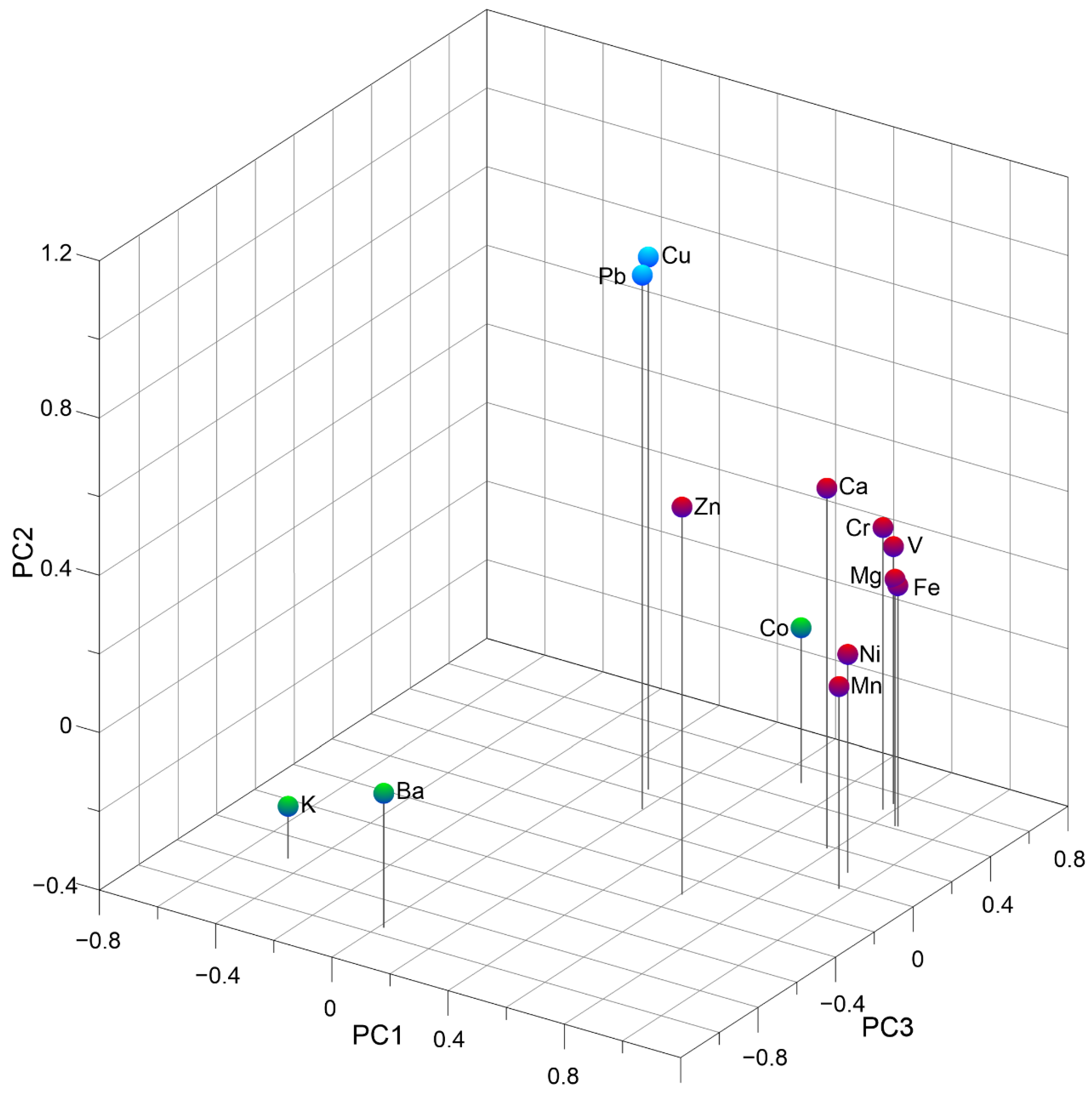
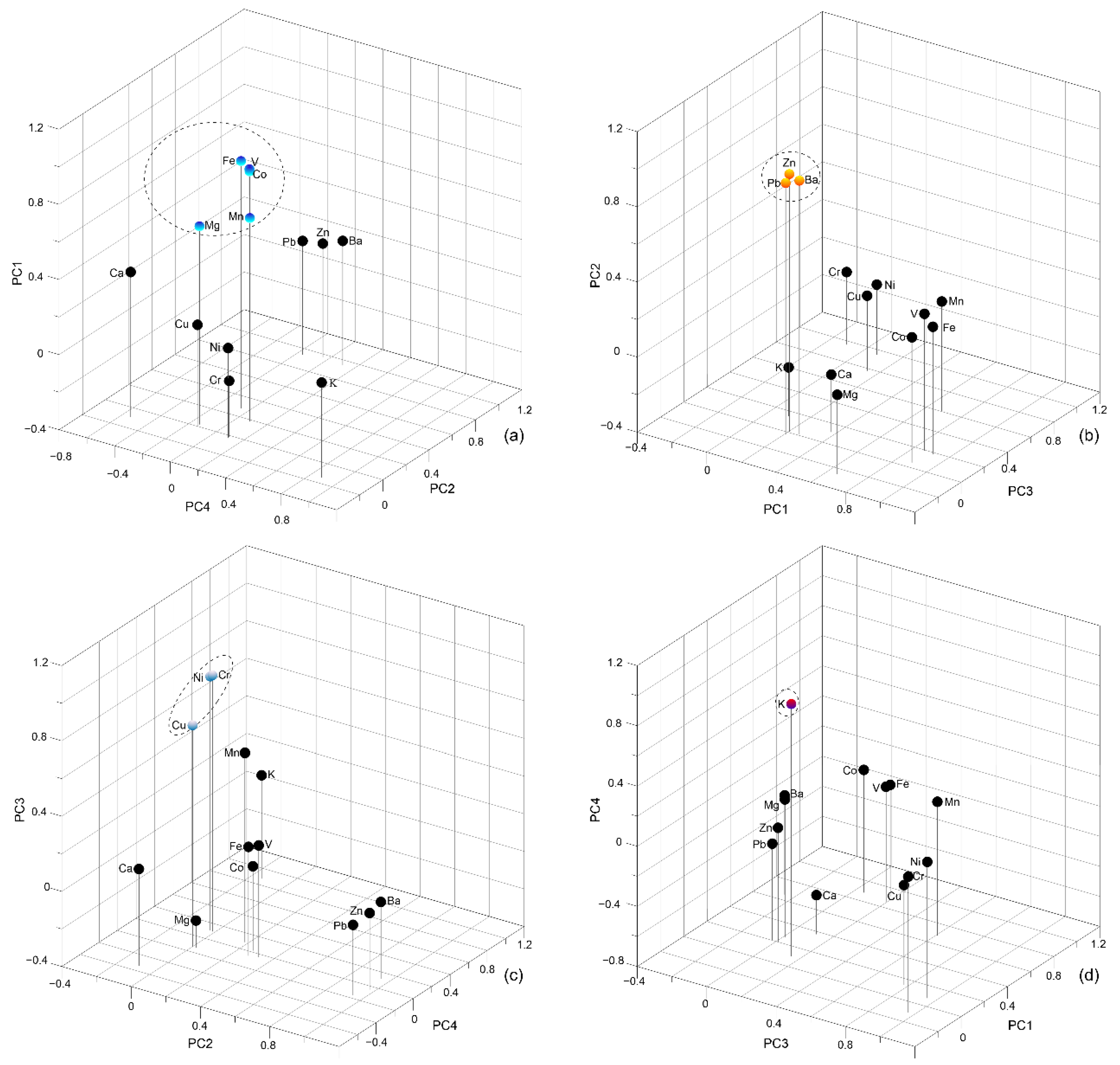

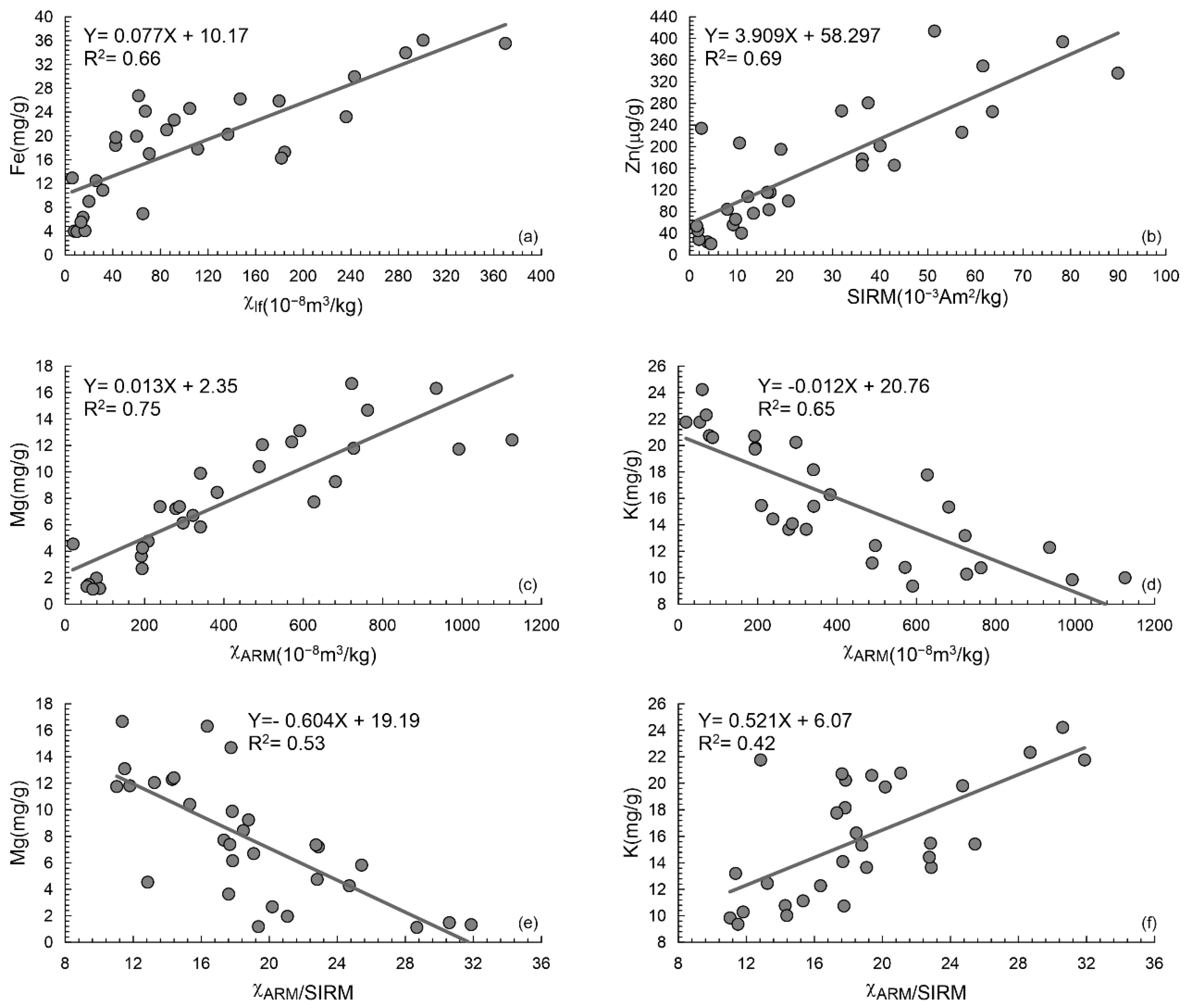
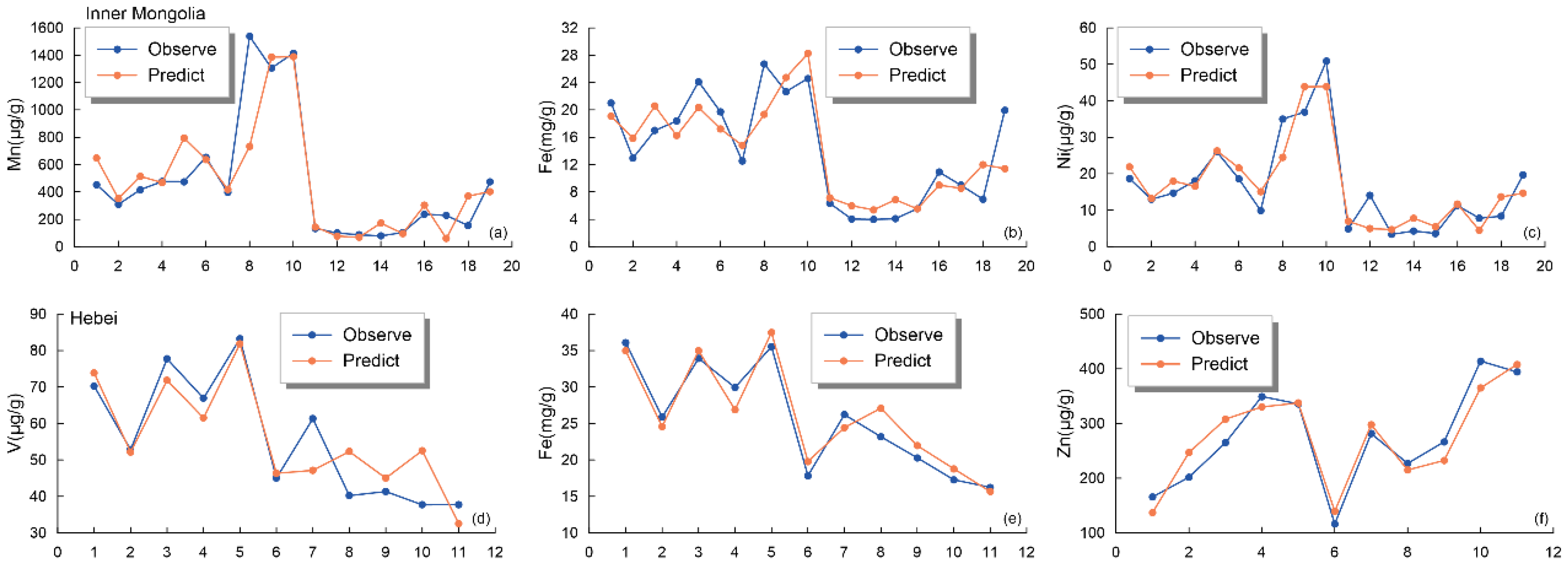
| Element | Inner Mongolia (n = 20) | Hebei (n = 15) | ||||
|---|---|---|---|---|---|---|
| Content in Mass (μg/g) | EF | Background Value (μg/g) | Content in Mass (μg/g) | EF | Background Value (μg/g) | |
| Mg (103) | 5.17 ± 2.86 | 1.03 ± 0.57 | 6.2 | 13.02 ± 2.54 | 2.85 ± 0.59 | 8.7 |
| K (103) | 18.32 ± 3.27 | 1.24 ± 0.31 | 20.8 | 10.83 ± 1.55 | 1.11 ± 0.14 | 18.5 |
| Ca (103) | 15.41 ± 9.14 | 1.14 ± 0.58 | 18 | 33.33 ± 7.85 | 2.91 ± 0.73 | 21.8 |
| V | 34.29 ± 17.33 | 0.9 ± 0.41 | 51.1 | 59.37 ± 20.53 | 1.51 ± 0.41 | 73.2 |
| Cr | 28.96 ± 15.36 | 0.94 ± 0.45 | 41.4 | 112.49 ± 116.05 | 3.08 ± 3.07 | 68.3 |
| Mn | 485.01 ± 443.22 | 1.2 ± 0.94 | 520 | 515.54 ± 129.43 | 1.58 ± 0.27 | 608 |
| Fe (103) | 14.6 ± 7.83 | 0.84 ± 0.39 | 23.1 | 26.89 ± 8.7 | 1.77 ± 0.43 | 28.2 |
| Co | 8.42 ± 4.97 | 1.11 ± 0.65 | 10.3 | 11.21 ± 5.05 | 1.66 ± 0.62 | 12.4 |
| Ni | 17.08 ± 12.44 | 1.14 ± 0.71 | 19.5 | 30.18 ± 16.59 | 1.84 ± 0.94 | 30.8 |
| Cu | 27.02 ± 41.62 | 2.48 ± 3.79 | 14.4 | 53.93 ± 14.98 | 4.74 ± 1.48 | 21.8 |
| Zn | 98.14 ± 64.7 | 2.25 ± 1.49 | 59.1 | 381.57 ± 414.7 | 9.14 ± 8.67 | 78.4 |
| Ba | 611.68 ± 117.92 | 1.58 ± 0.39 | 542 | 794.52 ± 1257.36 | 2.86 ± 4.08 | 497 |
| Pb | 50.48 ± 72.62 | 3.86 ± 5.47 | 17.2 | 125.58 ± 103.88 | 11.07 ± 8.02 | 21.5 |
| Mg | K | Ca | V | Cr | Mn | Fe | Co | Ni | Cu | Zn | Ba | Pb | |
|---|---|---|---|---|---|---|---|---|---|---|---|---|---|
| Inner Mongolia | |||||||||||||
| Mg | 1 | ||||||||||||
| K | −0.751 ** | 1 | |||||||||||
| Ca | 0.865 ** | −0.551 * | 1 | ||||||||||
| V | 0.967 ** | −0.849 ** | 0.798 ** | 1 | |||||||||
| Cr | 0.948 ** | −0.843 ** | 0.802 ** | 0.966 ** | 1 | ||||||||
| Mn | 0.828 ** | −0.425 | 0.854 ** | 0.713 ** | 0.736 ** | 1 | |||||||
| Fe | 0.981 ** | −0.748 ** | 0.857 ** | 0.974 ** | 0.953 ** | 0.828 ** | 1 | ||||||
| Co | 0.571 ** | −0.456 * | 0.566 ** | 0.587 ** | 0.500 * | 0.475 * | 0.604 ** | 1 | |||||
| Ni | 0.857 ** | −0.522 * | 0.810 ** | 0.761 ** | 0.796 ** | 0.927 ** | 0.847 ** | 0.401 | 1 | ||||
| Cu | 0.429 | −0.442 | 0.666 ** | 0.458 * | 0.500 * | 0.248 | 0.414 | 0.234 | 0.312 | 1 | |||
| Zn | 0.523 * | −0.338 | 0.632 ** | 0.513 * | 0.556 * | 0.580 ** | 0.544 * | 0.061 | 0.538 * | 0.522 * | 1 | ||
| Ba | −0.396 | 0.674 ** | −0.206 | −0.491 * | −0.476 * | −0.007 | −0.403 | −0.362 | −0.114 | −0.257 | 0.268 | 1 | |
| Pb | 0.429 | −0.38 | 0.698** | 0.424 | 0.485 * | 0.329 | 0.408 | 0.201 | 0.367 | 0.984 ** | 0.577 ** | −0.156 | 1 |
| Hebei | |||||||||||||
| Mg | 1 | ||||||||||||
| K | −0.152 | 1 | |||||||||||
| Ca | 0.133 | −0.115 | 1 | ||||||||||
| V | 0.392 | 0.009 | 0.267 | 1 | |||||||||
| Cr | −0.218 | 0.234 | 0.055 | 0.043 | 1 | ||||||||
| Mn | 0.294 | 0.148 | 0.217 | 0.753 ** | 0.538 * | 1 | |||||||
| Fe | 0.495 | 0.006 | 0.308 | 0.970 ** | 0.037 | 0.785 ** | 1 | ||||||
| Co | 0.471 | 0.077 | 0.309 | 0.829 ** | −0.061 | 0.638 * | 0.875 ** | 1 | |||||
| Ni | −0.095 | 0.253 | 0.128 | 0.194 | 0.974 ** | 0.660 ** | 0.187 | 0.093 | 1 | ||||
| Cu | −0.113 | −0.025 | 0 | 0.33 | 0.627 * | 0.437 | 0.336 | 0.212 | 0.613 * | 1 | |||
| Zn | 0.19 | −0.137 | 0.035 | 0.482 | −0.023 | 0.317 | 0.449 | 0.432 | 0.005 | 0.029 | 1 | ||
| Ba | 0.191 | −0.004 | −0.039 | 0.511 | −0.005 | 0.384 | 0.496 | 0.483 | 0.029 | −0.003 | 0.975 ** | 1 | |
| Pb | 0.198 | −0.18 | 0.181 | 0.468 | −0.061 | 0.243 | 0.437 | 0.424 | −0.04 | 0.015 | 0.962 ** | 0.918 ** | 1 |
| Inner Mongolia | Hebei | ||
|---|---|---|---|
| χlf (10−8 m3/kg) | Range | 5.71–104.50 | 111.24–369.81 |
| Mean ± SD | 44.0 ± 31.16 | 215.92 ± 79.03 | |
| χARM (10−8 m3/kg) | Range | 19.24–680.9 | 287.56–1125.61 |
| Mean ± SD | 245.57 ± 182.18 | 699.82 ± 247.33 | |
| SIRM (10−3 Am2/kg) | Range | 1.50–36.26 | 16.27–89.92 |
| Mean ± SD | 12.38 ± 10.31 | 51.86 ± 21.21 | |
| ARM (10−6 Am2/kg) | Range | 7.66–271.06 | 114.48–448.09 |
| Mean ± SD | 97.76 ± 72.52 | 278.59 ± 98.46 | |
| S-ratio | Range | 0.86–0.98 | 0.88–0.97 |
| Mean ± SD | 0.92 ± 0.04 | 0.94 ± 0.03 | |
| χARM/χlf | Range | 0.97–36.58 | 2.53–6.20 |
| Mean ± SD | 7.06 ± 7.34 | 3.35 ± 1.05 | |
| χARM/SIRM (10−5 m/A) | Range | 12.84–31.88 | 11.03–17.75 |
| Mean ± SD | 21.58 ± 4.92 | 14.06 ± 2.5 | |
| SIRM/χlf (105 A/m) | Range | 0.08–1.6 | 0.14–0.43 |
| Mean ± SD | 0.33 ± 0.32 | 0.24 ± 0.08 |
| Mg | K | Ca | V | Cr | Mn | Fe | Co | Ni | Cu | Zn | Ba | Pb | |
|---|---|---|---|---|---|---|---|---|---|---|---|---|---|
| χlf | 0.863 ** | −0.798 ** | 0.780 ** | 0.772 ** | 0.341 | 0.234 | 0.813 ** | 0.414 * | 0.424 * | 0.425 * | 0.729 ** | −0.560 ** | 0.445 * |
| SIRM | 0.842 ** | −0.790 ** | 0.796 ** | 0.697 ** | 0.310 | 0.303 | 0.734 ** | 0.323 | 0.444 * | 0.391 * | 0.833 ** | −0.591 ** | 0.493 ** |
| χARM | 0.867 ** | −0.804 ** | 0.788 ** | 0.693 ** | 0.281 | 0.406 * | 0.754 ** | 0.338 | 0.482 ** | 0.396 * | 0.772 ** | −0.559 ** | 0.462 * |
| S-ratio | 0.583 ** | −0.504 ** | 0.455 * | 0.639 ** | 0.380 * | 0.441 * | 0.652 ** | 0.606 ** | 0.502 ** | 0.081 | 0.160 | −0.450 * | 0.004 |
| χARM/χlf | −0.244 | 0.123 | −0.251 | −0.195 | −0.158 | −0.050 | −0.211 | 0.053 | −0.145 | −0.199 | −0.268 | −0.032 | −0.190 |
| χARM/SIRM | −0.726 ** | 0.649 ** | −0.707 ** | −0.622 ** | −0.406 * | −0.339 | −0.650 ** | −0.423 * | −0.475 ** | −0.324 | −0.608 ** | 0.565 ** | −0.362 * |
| SIRM/χlf | −0.084 | −0.025 | −0.088 | −0.065 | −0.076 | 0.047 | −0.071 | 0.147 | −0.035 | −0.129 | −0.112 | −0.172 | −0.100 |
| R2 | F | Signif. F | Regression Equations | ||
|---|---|---|---|---|---|
| Inner Mongolia | 0.635 | 32.332 | 0.000 | Mg = 1.891+ 0.013 χARM | |
| 0.587 | 26.595 | 0.000 | V = 14.315 + 0.432 χlf | ||
| 0.658 | 35.672 | 0.000 | Cr = 11.138 + 0.07 χARM | ||
| 0.742 | 52.728 | 0.000 | Mn = 2.219 + 38.228 SIRM | ||
| 0.686 | 40.343 | 0.000 | Fe = 5.342 + 0.036 χARM | ||
| 0.841 | 95.939 | 0.000 | Ni = 2.727 + 1.136 SIRM | ||
| Hebei | 0.696 | 12.43 | 0.004 | V = 30.457 − 0.036 χARM + 0.236 χlf | |
| 0.78 | 18.749 | 0.001 | Fe = 12.862 + 0.107 χlf − 0.015 χARM | ||
| 0.518 | 11.75 | 0.008 | Zn = 670.842 − 28.205 χARM/SIRM | ||
| 0.595 | 15.716 | 0.003 | Pb = 295.68 − 13.852 χARM/SIRM | ||
Publisher’s Note: MDPI stays neutral with regard to jurisdictional claims in published maps and institutional affiliations. |
© 2022 by the authors. Licensee MDPI, Basel, Switzerland. This article is an open access article distributed under the terms and conditions of the Creative Commons Attribution (CC BY) license (https://creativecommons.org/licenses/by/4.0/).
Share and Cite
Qiao, Q.; Piper, J.D.A.; Lv, Z. Multivariate Analysis of Magnetic Parameters and Trace Metals in Atmospheric Dustfall and Its Environmental Implications in Northern China. Minerals 2022, 12, 1598. https://doi.org/10.3390/min12121598
Qiao Q, Piper JDA, Lv Z. Multivariate Analysis of Magnetic Parameters and Trace Metals in Atmospheric Dustfall and Its Environmental Implications in Northern China. Minerals. 2022; 12(12):1598. https://doi.org/10.3390/min12121598
Chicago/Turabian StyleQiao, Qingqing, John D. A. Piper, and Zhuangzhuang Lv. 2022. "Multivariate Analysis of Magnetic Parameters and Trace Metals in Atmospheric Dustfall and Its Environmental Implications in Northern China" Minerals 12, no. 12: 1598. https://doi.org/10.3390/min12121598
APA StyleQiao, Q., Piper, J. D. A., & Lv, Z. (2022). Multivariate Analysis of Magnetic Parameters and Trace Metals in Atmospheric Dustfall and Its Environmental Implications in Northern China. Minerals, 12(12), 1598. https://doi.org/10.3390/min12121598





